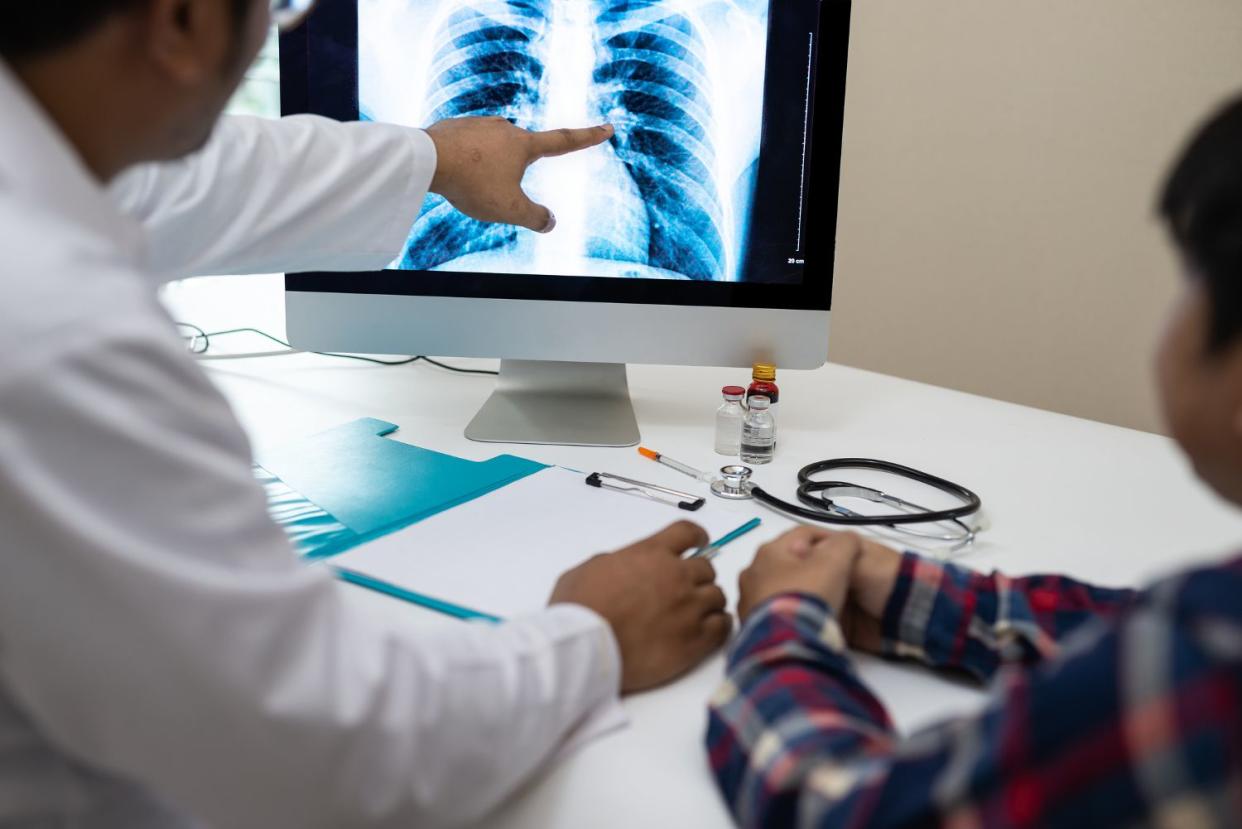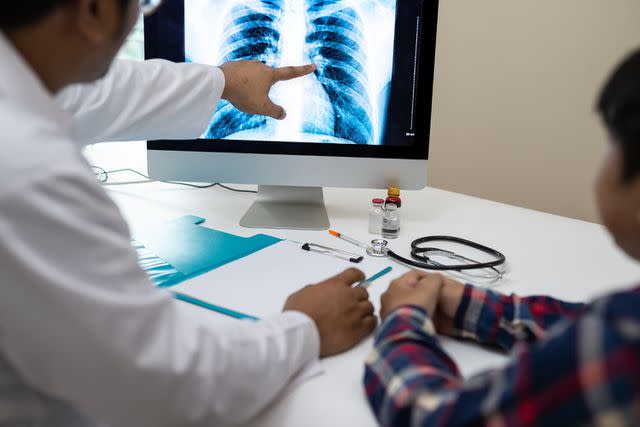What Is Spinal Tuberculosis?

x-reflexnaja / Getty Images
Medically reviewed by Smita Patel, MD
Tuberculosis (TB) is a bacterial infection that, if left untreated, can be fatal. This condition, caused by the bacterium Mycobacterium tuberculosis, typically affects the lungs. However, it can affect other parts of the body, including the bones. Spinal tuberculosis—also called Pott's disease—is the most common type of TB affecting the bones.
This article discusses spinal tuberculosis—symptoms, causes, diagnosis, treatment, and prognosis for this condition.

x-reflexnaja / Getty Images
Symptoms of Spinal Tuberculosis
Spinal tuberculosis typically affects the thoracic spine in the upper back and the lumbar spine in the lower back. Symptoms of spinal tuberculosis are vague, particularly early on. They include:
Back pain
Muscle spasms
Stiffness
As the disease progresses, symptoms can become more apparent, causing:
Joint deformities/scoliosis (an abnormal curve in the spine)
Swelling
Decreased range of motion
Ulcers
Swollen lymph nodes
Cold abscess (pockets of pus)
Spinal tuberculosis can put pressure on the spinal cord and nerves that exit the spine, causing neurological symptoms such as weakness in the legs, numbness, tingling, or even paralysis.
Only around 1 in 3 people who have bone tuberculosis (including spinal TB) will have typical symptoms of TB, including:
Decreased appetite
Low-grade fever (usually at night)
Weight loss
Chills
Weakness
Fatigue
Stages of Bone Tuberculosis
Tuberculosis in the bones (including the spine) often progresses in the following stages:
Synovitis: Night pain and muscle spasms
Early arthritis: Joint pain, muscle spasms, some effect on daily function
Late arthritis: Increased pain and spasms, decreased function, over 75% loss of range of motion
Advanced arthritis with subluxation and dislocation: Deformity of the involved joints, severely reduced range of motion
Terminal arthritis: Joint becomes "fused" and no longer moves
What Causes Spinal Tuberculosis?
Spinal tuberculosis occurs when M. tuberculosis infects bones in the spine, called vertebrae. This bacterium spreads from person to person through the air. Tuberculosis in the lungs is very contagious, but tuberculosis in other areas of the body—including the spine—is not typically contagious. Once it passes from an infected person to another, it can spread from the lungs to other body parts, including the spine.
Learn More: Causes and Risk Factors of Tuberculosis
Diagnosis of Spinal Tuberculosis
Spinal tuberculosis is not very common, and diagnosis is often delayed. Tuberculosis that affects the bones and joints (including the spine) occurs in around 1% to 3% of people with TB.
In addition, symptoms of spinal TB are similar to other, more common, conditions that cause back pain and stiffness, such as arthritis or a muscle strain—and people with spinal tuberculosis rarely have the lung infection that most commonly occurs with tuberculosis.
Related: Symptoms of Spinal Arthritis
Skin and Blood Tests
The presence of M. tuberculosis in the body can be detected with skin or blood tests.
The Mantoux tuberculin skin test is performed by injecting a small amount of tuberculin-purified protein derivative under the skin (typically on the inner forearm). The test is read 48 to 72 hours after the injection.
If a firm, swollen bump develops, it is measured in millimeters. A positive result is a bump that measures 5 millimeters or more for a person who has recently been exposed to another person with TB.
Blood tests can also be performed to detect the presence of TB bacteria. Neither the skin nor blood tests specifically diagnose spinal tuberculosis—they only signify whether or not the bacteria is present.
A tissue acid-fast bacilli culture test is ideal for spinal tuberculosis, but it can be difficult to obtain a sample. In addition, results are often unavailable for six or more weeks, which could delay necessary treatment.
While many people exposed to M. tuberculosis won't have any symptoms, some may have a latent TB infection that may develop into active TB. Testing for latent TB is recommended for anyone at greater risk of exposure.
Imaging
Imaging is an important part of diagnosing spinal tuberculosis.
X-rays typically show decreased height of the vertebrae, bone erosion, rounding of the spine, and masses growing next to the spine. Magnetic resonance imaging (MRI) can show swelling in the bone marrow, abscesses in the bone, and narrowing of the spinal canal (space around the spinal cord).
Computed tomography (CT scan) can be useful for examining bone destruction caused by TB, and positron emission tomography (PET scan) helps to distinguish bone infection from soft tissue infection.
Related: How Tuberculosis (TB) Is Diagnosed
How Is Spinal Tuberculosis Treated?
Treatment for spinal tuberculosis involves a combination of medications and other interventions, depending on the severity of damage that has occurred.
Medications
Medication for tuberculosis can last for four, six, or nine months, depending on the treatment protocol prescribed by your healthcare provider.
Medications used in the four-month protocol include:
Priftin (rifapentine)
Avalox (moxifloxacin)
Rifater, Rimstar, Voractiv (pyrazinamide)
Hydra, Hyzyd, Isovit, (isoniazid)
Medications used in the six- or nine-month "RIPE" protocol include:
Rifampin
Isoniazid
Pyrazinamide
Ethambutol
Drug-Resistant TB
In some cases, tuberculosis can be resistant to first-line medications used to treat this condition. Drug-resistant TB is difficult to manage and requires treatment by a medical expert. These cases can sometimes be treated with fluoroquinolone antibacterial drugs, but these medications have significant negative side effects.
Surgery
Spinal tuberculosis often requires surgery as part of treatment. The exact procedures used depend on the extent of bone damage.
Surgery can include cleaning out infected tissues (called debridement), removing eroded bone, placing screws and rods to stabilize the spine, or fusing vertebrae together.
Surgery can also involve bone grafting—taking a piece of bone from one place in the body and grafting it into the spine.
Prognosis for Spinal Tuberculosis
Spinal tuberculosis that isn't treated can be fatal. Early detection is key for improved prognosis. Unfortunately, diagnosis of spinal TB is often delayed until the spine is deformed. While treatment takes many months, people can recover from spinal tuberculosis with medication and surgery.
Summary
Tuberculosis is a bacterial infection that usually affects the lungs. However, it can spread to other parts of the body, including the spine. Spinal tuberculosis can be difficult to diagnose—early symptoms include stiffness, back pain, and muscle spasms, which occur with other, more common back injuries.
Spinal tuberculosis is diagnosed with skin or blood tests, tissue cultures, and imaging. Treatment includes medication and, often, surgery to treat spine damage. Early diagnosis and treatment are essential for a favorable prognosis.
A Word From Verywell
Spinal tuberculosis is a serious disease. Talk to your healthcare provider if you have persistent back pain—particularly without an injury. Imaging can provide important information about the underlying cause of your symptoms. If you've been exposed to someone with TB, seek immediate medical attention.

